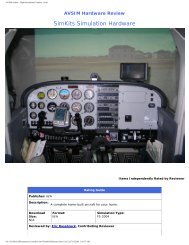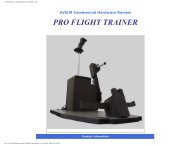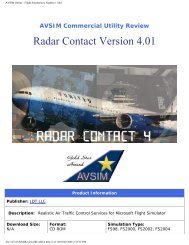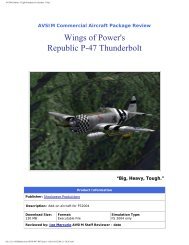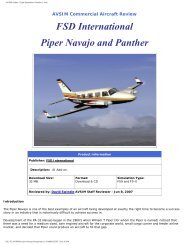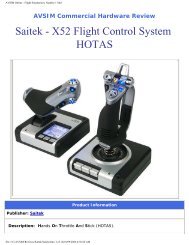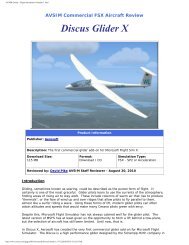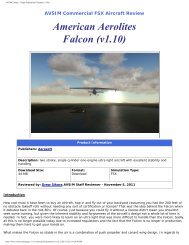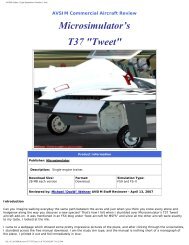Concorde-X - Avsim
Concorde-X - Avsim
Concorde-X - Avsim
You also want an ePaper? Increase the reach of your titles
YUMPU automatically turns print PDFs into web optimized ePapers that Google loves.
AVSIM Online - Flight Simulation's Number 1 Site!<br />
Publishers: Flight Sim Labs<br />
AVSIM Commercial FSX Aircraft Review<br />
Description: Supersonic add-on aircraft.<br />
http://www.avsim.com/pages/0111/FltSimLab/SST.html (1 of 17)11/01/2011 5:08:54 PM<br />
<strong>Concorde</strong>-X<br />
Product Information
AVSIM Online - Flight Simulation's Number 1 Site!<br />
Download Size:<br />
322 MB - basic package<br />
105 MB - SP1<br />
120 MB - SP2<br />
French Speedy Gonzales<br />
Format:<br />
Download<br />
Simulation Type:<br />
FSX<br />
Reviewed by: Angelique van Campen AVSIM Senior Staff Reviewer - January 10, 2011<br />
This time a totally different aircraft, a review about the Aerospatiale <strong>Concorde</strong>. In many aspects the <strong>Concorde</strong> was and has been<br />
a different aircraft. Not only because of its shape, but also of her cruising speed. Fortunately, after the Paris accident, Air France<br />
in conjunction with local authorities, decided to stop flying this commercial aircraft. You could ask yourself if today’s aviation was<br />
ready for this kind of advanced and supersonic aircraft. Whatever the real reason was and is, Flight Sim Labs decided to go for<br />
the <strong>Concorde</strong>-X.<br />
This aircraft is in many aspects very similar to certain PMDG or Leonardo SH products. We at AVSIM are curious if this statement<br />
is correct, knowing already that this won't be an easy job to determine. The <strong>Concorde</strong>-X is not a regular airplane and although<br />
being a member of the commercial aviation world, it needs to be controlled and monitored in her own way. No, there are not yet<br />
any conclusions, but I can tell you in advance that it was worth reviewing this Flight Sim Labs <strong>Concorde</strong>-X. When you want an<br />
extraordinary model in your hanger, then buying this model is worth every penny.<br />
Some <strong>Concorde</strong> history<br />
The <strong>Concorde</strong> was a supersonic passenger airplane. Air France and British Airways where the only airlines who bought the<br />
<strong>Concorde</strong>. Not surprising since the French and British governments subsidized the creation of this supersonic delta wing airplane.<br />
Her French maiden flight was in 1969 with her last flight in October 24, 2003, a result of the terrible accident at Paris. The<br />
<strong>Concorde</strong> was unique since it could fly at a cruising altitude of 18 km – approximately 59.000 feet - with a speed of Mach 2.04.<br />
This is twice the speed of sound. With these performances the <strong>Concorde</strong> could fly from London to New York in less than three<br />
hours. For many reasons the <strong>Concorde</strong> was a luxury project from the French and British governments. At a certain moment it had<br />
nothing to do anymore with commercial capacities.<br />
Back in the mid-50s, there were plans to develop a supersonic commercial plane. The development wasn't as easy as everybody<br />
had hoped for. Because of the French and British governments, who took part in this project, decisions where slowed down.<br />
Another problem was having two production lines, one in France and one in Britain, which was and still is very unusual. Despite<br />
all kinds of internal problems and political influences, this Corporation between two countries was the predecessor of Airbus<br />
Industries, which later became EADS (European Aeronautic Defense and Space Company).<br />
http://www.avsim.com/pages/0111/FltSimLab/SST.html (2 of 17)11/01/2011 5:08:54 PM
AVSIM Online - Flight Simulation's Number 1 Site!<br />
Copyright <strong>Concorde</strong> SST.Com<br />
LH picture:<br />
At Blagnac / Toulouse Airport, Aerospatiale is proud to show to<br />
at least 1000 spectators and employees the very first<br />
<strong>Concorde</strong> (F-WTSS). Because of her shape, delta wing, special<br />
powered engines and foldable nose, it’s a strange and<br />
extraordinary looking bird. The abroad presentation was<br />
unfortunately not meaning that the <strong>Concorde</strong> was ready for<br />
her maiden flight. Lots of things had to be done after this date<br />
before for her 1st flight.<br />
RH picture:<br />
<strong>Concorde</strong> prototype 002 (G-BSST) made her first flight from<br />
the British airport Filton. What’s also applicable for the French<br />
model, the <strong>Concorde</strong> had to prove to the commercial aviation<br />
world what and how she was. Together with her strange<br />
looking wing and fuselage, it wasn’t an easy job to convince<br />
other airlines to buy the <strong>Concorde</strong>.<br />
Both countries had, due to the government influences, lots of delays but finally the very first <strong>Concorde</strong> made her maiden flight on<br />
March 2, 1969. Around a month later on April 9, from the British airport Filton, the first British model took off. The first trans-<br />
Atlantic flight was around September 1971, however regular flights had to wait until 1976.<br />
In fact, the <strong>Concorde</strong> was no longer economical to fly. This was because of the high fuel costs. The <strong>Concorde</strong> offered European or<br />
American business people to fly to their destination, do business, and fly back to their own country in the same day. Businesswise<br />
this was great, but for ordinary passengers it was too expensive. Too expensive because of the high fuel costs, which resulted in<br />
ticket prices of approximately €11.000 each.<br />
When the recession occurred and fuel costs increased even more, both airlines decided to stop the trans-Atlantic flights. In fact,<br />
this was the end of the <strong>Concorde</strong>! Not only were fuel costs the major problem, it was also beaten by the slower and much<br />
cheaper American Boeing 747, Lockheed L-1011, and the McDonnell Douglas DC-10 Series wide-bodies.<br />
http://www.avsim.com/pages/0111/FltSimLab/SST.html (3 of 17)11/01/2011 5:08:54 PM
AVSIM Online - Flight Simulation's Number 1 Site!<br />
Installation, reading, reading and then flying<br />
The Flight Sim Labs <strong>Concorde</strong>-X is not an add-on airplane you can easily power-up, start<br />
the engines, and do some checks all within a few minutes. First of all the user needs to<br />
read the manuals. They are well written, informative, and useful. Not only useful, but I<br />
should say “a must to read”.<br />
As far as possible within FSX, many systems are simulated and because of this, you need<br />
to learn all the ins-and-outs of this aircraft. You and I will learn that your virtual flight<br />
engineer will do a lot of things for you as he did it in real aircraft. Furthermore, your copilot<br />
is also doing a lot of things for you, but here it’s the same; you still need to do a lot of<br />
things as the pilot flying.<br />
The software installation including the Service Packs shouldn’t give you any problems. In<br />
other words, it's a straightforward process. Since the release of the initial software, Flight<br />
Sim Labs has published additional Service Packs. The service packs are not only there to<br />
offer improvements and to solve known bugs or problems, a tutorial was added with<br />
service pack 1.<br />
Test System<br />
Intel Core Extreme i7-965<br />
3.2Ghz<br />
6GB Tri-Channel DDR3 1600Mhz<br />
EVGA GTX-285 For the Winner<br />
Triple WD VelociRaptor 300GB<br />
HDD<br />
Single WD 1TB HDD<br />
Windows 7 Ultimate X64<br />
Flight Simulator FSX SP2<br />
Flight Simulator FS9.1<br />
Saitek Pro Flight System<br />
Saitek X-65F<br />
TrackerIR Pro 4<br />
TrackerClip Pro<br />
Flying Time:<br />
46 hours<br />
Just a shortcut, follow the tutorial! It's worth it. A lot of effort was put into the making of<br />
this tutorial and it will help you for sure, it helped me to understand, fly and master this beautiful aircraft. And please don't think<br />
that the tutorial is enough. You absolutely need to read the basic manual and after that, you can read and play with the aircraft<br />
simultaneously.<br />
Let’s go back to the installation; after you installed the basic package and the Service Packs, a third installation is needed and<br />
that’s the Delco Carousel IV-A Inertial navigation system. When you’re ready with all the software installations, you’ll find under<br />
the Windows Start button a folder named Flight Sim Labs, Ltd – <strong>Concorde</strong>X - documentation.<br />
The documentation folder offers the flying manual and tutorial. The flying manual, no more than 288 pages, offers you all the<br />
information needed to master this beautiful aircraft and when I say ALL, I mean ALL! The best way to go through this book is first<br />
to print it out and then you start reading it in combination with the FSX <strong>Concorde</strong>-X. This gives you the ability to learn and<br />
practice your skills on the <strong>Concorde</strong> flight deck. By the way; the tutorial is not just a tutorial. It’s a little bit like a user guide and<br />
it helps you via a step-by-step procedure through a simulated flight from London (EGLL) to New York (KJFK).<br />
http://www.avsim.com/pages/0111/FltSimLab/SST.html (4 of 17)11/01/2011 5:08:54 PM
AVSIM Online - Flight Simulation's Number 1 Site!<br />
A few shots of the installation process. Suppose you haven’t got the latest DirectX on your PC,<br />
this installation process will check it and if needed, update it via Microsoft. Although no<br />
screenshots are shown of the Service Packs, the right hand screenshot shows you the<br />
installation of the integrated mounted Delco INS CDU.<br />
What else is available? The installer added some <strong>Concorde</strong> Routes. Some of you probably have no idea which and what<br />
destinations this airplane was flying to. In other words, Flight Sim Labs offers you all the original routes the <strong>Concorde</strong> were flying.<br />
These are not only British Airways routes, but as expected also Air France’s.<br />
Acrobat files offer you all the necessary information like latitude and longitude, which are later needed for the INS CDU (Inertial<br />
Navigation System). Just a small note; in the footer of these papers you will find copyrights SSTSIM 2005, which means that one<br />
of the developers was involved with the FS9 <strong>Concorde</strong> project.<br />
The Flight Sim Labs <strong>Concorde</strong> comes with five liveries. One of them is the Flight Sim Labs house colours. Then there's one from<br />
Air France and 3 of British Airways. Unfortunately there is no Aerospatiale house color of the first <strong>Concorde</strong> included. Instead of<br />
this, Flight Sim Labs offers their own livery.<br />
I preferred to see the other way around. You are right, there are no other airline liveries available and this is as real as it gets.<br />
Since there were no other airlines around flying the <strong>Concorde</strong>, there’s no need to add other liveries. Furthermore, depending on<br />
the livery you choose, you can either choose the captains or copilot seat. No I'm sorry, there's no option to go for the flight<br />
engineer’s seat! Last but not least, in the same folder you will also find an uninstaller, but I don't think additional information is<br />
needed to explain this.<br />
Not available via the Windows Start button, but only available via the FSX menu you have a Panel States and Load Flight option.<br />
It's not my intention to go in-depth discussing this since the manual offers full information about these options and sub-options.<br />
Worth to mention at this moment is the presence of a fuel and Aircraft Load program.<br />
These programs are fully integrated in FSX and therefore directly active. Regarding the Load Flight option; we are dealing here<br />
with a <strong>Concorde</strong>-X Preliminary flight. Once loaded, it seems you’re parked at a gate at London Heathrow with, of course, British<br />
airways livery. What I just wrote is based on default London Heathrow scenery. When you own Mega airport London Heathrow<br />
http://www.avsim.com/pages/0111/FltSimLab/SST.html (5 of 17)11/01/2011 5:08:54 PM
AVSIM Online - Flight Simulation's Number 1 Site!<br />
from Aerosoft, you will be parked at gate 420, however not exactly on the parking strip.<br />
It seems a small mistake, but this has nothing to do with the Flight Sim Labs <strong>Concorde</strong>-X. This is a known problem with many<br />
more airport sceneries where there is always a mismatch between the default FSX scenery and add-on scenery. The FSX add-on<br />
menu offers ground services which look very similar to PMDG menus. You will also find Panel State options and a few others like<br />
cold and dark, <strong>Concorde</strong>-X preliminary, ready for takeoff etc.<br />
Flying or first the cockpit?<br />
I don't think it is a good idea to fly straight out of the box for the simple reason that we first need to read the manuals and<br />
second, to explore the cockpit. Even for me as a reviewer and ex-professional ground engineer, I can't just power up the aircraft<br />
while sitting down in my cockpit seat and just go flying.<br />
The 2D cockpit and the Virtual Cockpit offer a realistic look of how this supersonic aircraft was and I can tell you, it's beautiful<br />
and it looks very impressive with all those old-fashioned instruments, big switches and flight engineers panel. The <strong>Concorde</strong> was<br />
and still is a super slim airplane and because of this and her delta wing, there's not so much to see during a walk-around check.<br />
Although the engines are hanging underneath the wing/fuselage section, they are more or less mounted straight into the fuselage<br />
without a pylon as with all other modern airplanes. Then of course there’s the landing gear and that's it more or less. Oops, I<br />
forgot something; the strange drooping nose.<br />
Why this strange drooping nose is added, that’s something we will see later in one of the sections, but suppose I forgot it, there’s<br />
always the manual that will help you out as to why this nose has different positions for takeoff, flight, approach and landing.<br />
Making my walk-around check starting at the nose and heading aft via the left hand side, I can only come to one conclusion; I'm<br />
impressed about the available details and tiny things. Since there's not so much to see about the Delta wing, I'm focusing on the<br />
engine cowlings and undercarriage … oops, landing gear! FSX makes walk around checks together with special software as real as<br />
it gets and therefore I can have a very close look of the main gear. And then I don't mean only the struts but also the tires,<br />
hydraulic lines, electrical wires etc. This and a few other things gives me the feeling that we dealing with a highly realistic<br />
<strong>Concorde</strong>.<br />
In that respect does the <strong>Concorde</strong> have something mysterious, something from outer space! No, that's rubbish. Delta wing<br />
aircraft are common in military models so why not in commercial aviation? Let's first have a look to a few screenshots I made<br />
during my walk around check.<br />
http://www.avsim.com/pages/0111/FltSimLab/SST.html (6 of 17)11/01/2011 5:08:54 PM
AVSIM Online - Flight Simulation's Number 1 Site!<br />
Is there a need to write something more about these screenshots? Normally I don't see any reason for that, but let's give you<br />
one small example; the tires of the main- and nose wheels versus polygons. The wheels or tires look very realistic and that<br />
means they are more or less round. Looking closely to the main wheels, I even got the idea that the outside of the tire is made of<br />
photo realistic material. I could be wrong, but I can read the word Michelin printed on it. By the way, this is not only applicable<br />
for the tires, but also for the rim. Since we're here, let's have a look at the engine cowling.<br />
The engine cowling is as far as I can judge, again covered with digitalized material because of the presence of some placards and<br />
text. Normally this is a problem with other vendors, where zooming-in on these tiny things not always results in sharp images.<br />
Okay, let's give you another example and that’s the nose landing gear. It looks a bit weird; first of all it's a very tall, slim landing<br />
gear and its location, which is positioned far aft compared to the very long nose and it comes with two tiny tires. And the same<br />
as we saw with the main landing gear; highly detailed tires with Michelin inscription, photorealistic rim and an awesome nose<br />
landing gear strut and not to forget the nose landing gear doors.<br />
I’ll continue with my walk-around check and via the tail I’ll heading to the right hand wing and back to the nose gear. This<br />
concludes the end of my virtual trip. Up one of the stairs I’ll pass via the virtual FWD cabin to the cockpit.<br />
Not the entire virtual cabin is simulated but only the front part or to be precise, business- and/or first class. Via this area and the<br />
FWD pantry we enter the stretched cockpit. I'm aware that this is only visible when you enter the Virtual Cockpit, but when you<br />
go for the 2D cockpit, you won’t see all this.<br />
Mentioned before; the cockpit is full with switches, switches and even more switches. You find switches on the overhead panel,<br />
on the glare shield panel, on the center instrument panel, on the side panels and the flight engineer panel and whatever else I’ve<br />
forgotten. When you're grown up with modern aircraft like Boeing or Airbus, you’ll probably find it a mess and an unorganized<br />
area, however this is how it was. Let's keep it simple and let's first start with 2D cockpit.<br />
http://www.avsim.com/pages/0111/FltSimLab/SST.html (7 of 17)11/01/2011 5:08:54 PM
AVSIM Online - Flight Simulation's Number 1 Site!<br />
Via the FSX menu you'll find out that the 2D cockpit comes with lots of subpanels. It's up to you which ones you want to use, but<br />
you have enough choices to get a detailed view of certain sub-panels. As with other add-on models, the Virtual Cockpit will<br />
overwhelm you, but before we continue let's first have a look to some 2D cockpits screenshots.<br />
Only two 2D cockpit screenshots?<br />
It’s not much, but believe me more is not needed since the<br />
Virtual Cockpit is the one you should fly with. Although the<br />
frames of the 2D are slightly higher, the VC gives you the real<br />
<strong>Concorde</strong> effect and the droopable nose and windshield effects.<br />
For some reason this virtual cockpit of the <strong>Concorde</strong> isn't as normal as I’ve seen with others. Why is that? It seems a lot of heavy<br />
duty material is used to create the overall cockpit and with that I mean the side panels, overhead panels, center panel,<br />
instrument panels, flight engineers panels etc. Ok, the virtual model is of course different, but together with digital material, a<br />
realistic virtual cockpit is something you like or you don't like.<br />
Very important when using digital material is the quality of the source files. When the 3D designer has to make all those panels<br />
himself, he or she can make it in his or her own way. In his or her own way also means that's it's not always as real as you would<br />
like and it could be that the overall look becomes cartoonish. On the other hand, good digital material and thus high quality photo<br />
material is essential to create an “as real as it gets” virtual cockpit.<br />
The <strong>Concorde</strong> virtual cockpit looks very realistic in my personal opinion, but I have to be honest, there are a few parts where the<br />
digital material could be better. I would like to see an FSX virtual cockpit that looks as real as it gets, but know that this is more<br />
or less impossible. Anyway, I'm satisfied! By the way, creating an old virtual cockpit like this <strong>Concorde</strong> is not as easy as you<br />
think. When these airplanes are still flying then there is always a possibility to make some updated real images. Unfortunately,<br />
the aircraft doesn't fly any more and although a few of them are still statically available, making real photos is not as easy since<br />
the developer could live at the other side world and doesn't have access to them.<br />
Entering the Virtual Cockpit via the cabin is different than with today’s modern aircraft. One of the reasons for this is the long<br />
corridor along all kinds of computer racks before access is given to the actual cockpit. Once we have reached the cockpit, on our<br />
right hand side is the flight engineer’s workstation. It can be clearly seen and almost felt as to how small this area is.<br />
Nonetheless, all the panels, seats, upholstery, floor carpet and whatever else, gives a realistic impression.<br />
http://www.avsim.com/pages/0111/FltSimLab/SST.html (8 of 17)11/01/2011 5:08:54 PM
AVSIM Online - Flight Simulation's Number 1 Site!<br />
The <strong>Concorde</strong> may be revolutionary for its time but the cockpit is full of old-fashioned instruments and big switches. Looking<br />
closely to all those instruments and switches, the developers tried to create a 3D effect which worked out pretty well. I can write<br />
what I want, either you believe me or you don't believe me, but the best is always to find real cockpit images on for example<br />
Airliners.Net to compare them with. When you have seen those and compare them with this <strong>Concorde</strong>-X, there's only one<br />
conclusion; very realistic!<br />
Every screenshot tells you something, something that's unique, something about hidden features and more of those tiny details. I<br />
think when I take my time staring for hours at all the individual switches, instruments lights, knobs, selectors and handles, I will<br />
find something you haven't seen before or what’s not correct or what could be better. Enough of this cockpit; I’ll make a full turn<br />
back to the cockpit entrance, to get access to the virtual cabin.<br />
I have to be honest; the virtual cabin is rather limited. Limited means in this case it's just the first and/or business class that is<br />
simulated. That it is limited doesn’t matter to me since what counts for me is the virtual cockpit and the external model.<br />
The cabin is nice and that's it. There is only one exception and that is the small cabin windows and the altitude/Mach indicator.<br />
That indicator is something we will see during our test flight from London to New York.<br />
http://www.avsim.com/pages/0111/FltSimLab/SST.html (9 of 17)11/01/2011 5:08:54 PM
AVSIM Online - Flight Simulation's Number 1 Site!<br />
My in-between conclusion covering the walk-around check, the cockpit impression and virtual cabin tells me that a lot of effort<br />
has been put into the creation of this historical model. When I want, I can find something but let's be honest, it looks great. I<br />
think it's time to move on to the next section and that's our test flight.<br />
To make it a little bit easier, I combined the test flight together with the tutorial. I mentioned this before, the INS was for those<br />
days already a highly sophisticated piece of navigation means and together with the control display unit, pilots were able to enter<br />
a maximum of nine waypoints. Curious? Let’s move on to the next section.<br />
Test flight EGLL to KJFK or is it a tutorial flight?<br />
As said before, it's not really a test flight, but a regular flight with British Airways from London to New York. Testing the flight<br />
dynamics or flight characteristics is not easy at all. I may have a frozen PPL, I don't have an ATPL nor have I been a <strong>Concorde</strong><br />
pilot. On the other hand, it isn’t difficult to find out if this <strong>Concorde</strong> flies like a default airplane or if it is hard to fly.<br />
Then there's the question, what's my definition of hard to fly? For me “hard to fly” means that this aircraft is probably not doing<br />
what I want. I won't say that the <strong>Concorde</strong> will do what the sim pilot wants, but for sure I need to put some effort into it to get it<br />
there when I want. Of course, I could connect the autopilot as quickly as possible after lift-off as well as the auto throttle, but<br />
then I don't learn anything about how it flies.<br />
I studied more or less the whole manual before starting with the tutorial. I mentioned it before, you could start straightaway with<br />
the tutorial without reading the manual, but believe me that's not a good option. Although this tutorial will help you a lot, many<br />
times it refers to the manual. In other words, they expect you to read the manual before starting with the tutorial.<br />
Since the tutorial is well written, you'll find your way through it while busy with the New York preparations. I think it's a good<br />
moment to print out the tutorial. This gives you the possibility to read it, when needed, while staring at the respective panel.<br />
Let's give you some more advice; don't do it from memory or just by following the checklist! See the tutorial not as a piece of<br />
paper, but as an extended checklist. While the tutorial follows the checklist, there’s a lot of background information added or<br />
important references that are given and links to the manual. Enough about this, time to follow the virtual flight crew and see how<br />
they are doing. Oops, you’re the virtual flight crew!<br />
Since I'm part of the virtual flight crew and following the tutorial step-by-step, I don't see any surprises. This means the tutorial<br />
http://www.avsim.com/pages/0111/FltSimLab/SST.html (10 of 17)11/01/2011 5:08:54 PM
AVSIM Online - Flight Simulation's Number 1 Site!<br />
is really written for every kind of flight simmer, from beginner to the highly experienced. Although not realistic but very handy, is<br />
the possibility to start the engines with Ctrl+E. On the other hand, when you see it as a challenge you can still start the engines<br />
as they did it.<br />
In that case, you need to follow the tutorial together with the checklist. After the pushback - unfortunately there’s no pushback<br />
truck simulated - it's time to taxi to the runway. I can tell you that this is damned difficult. That it is so difficult doesn't surprise<br />
me since you have more or less the same problem as with any other big airplane like the 747 or Douglas DC-10/MD11. Okay,<br />
what's the problem then?<br />
The cockpit is situated far in front of the nose gear and making turns along the taxiways means you have to remember that your<br />
nose gear is approximately 10 meters behind you and that it could be that your nose is hanging above the grass while the actual<br />
nose wheels are still on the middle line of the taxiway. In real, pilots couldn't jump out to see where the nose gear was located,<br />
but we can. We can change to external view and continue with taxiing while turning the nose wheel and see when and how much<br />
we need to turn.<br />
Before making the takeoff it's time to take a deep breath, set the parking brake, double check the checklist and if needed, the<br />
tutorial. Remember one thing, the <strong>Concorde</strong> is not a fighter but once you commence takeoff, there's no way back. Your speeds<br />
increase rapidly and before you know you're airborne and then it goes faster, faster and faster. Okay, you could use the pause<br />
button but that's not realistic so don't even think about doing this!<br />
After you've stopped in front of the runway, lots of things should be done in a short time frame and although the virtual flight<br />
engineer is doing something for you, he is not doing all the work since you are the pilot in command. So let's put it like this,<br />
practice on dry ground and write down the most important items for your initial climb to 10,000 feet. After that's it doesn't mean<br />
you can relax, but instead you can take half a cup of coffee or tea.<br />
After takeoff you could either continue with manual flight or decide to connect the autopilot and flight director. A little bit later<br />
you connect the auto throttle. Feel free to do what you want, but remember you need to do a lot of things and you need to watch<br />
out for many other things. In that respect it's better to follow the tutorial even during the climb. If you feel confident, you can<br />
always disconnect and see how it really feels flying this <strong>Concorde</strong>-X.<br />
Now it's time to try it. I'm in my climb and most of the things are done, so it's fine to get the real <strong>Concorde</strong> feeling. I really have<br />
http://www.avsim.com/pages/0111/FltSimLab/SST.html (11 of 17)11/01/2011 5:08:54 PM
AVSIM Online - Flight Simulation's Number 1 Site!<br />
no idea how it should fly, but I think I can compare this aircraft with other sophisticated add-on models like the PMDG 747, MD-<br />
11 and the Leonardo SH MD80 Maddog. One thing is for sure, and that's the same with the previous models as well, it’s not an<br />
airplane where you quickly do the refueling, add some payload and start the engines etc.<br />
According to the tutorial and the settings I made, we're heading for an initial altitude of FL260. During this climb and the<br />
necessary settings I made, I can tell you that switching knobs, switches and whatever else, offers a realistic sound. Let's give you<br />
an example; when you set at the AFCP (Auto flight Control Panel) to a new altitude and you close your eyes while selecting the<br />
knob, it gives you the feeling you're in the real <strong>Concorde</strong>. You can hear the gears inside the panel turning. This is only one sound<br />
example, but there are many more.<br />
In the meantime our <strong>Concorde</strong>-X accelerates to a VMO of 400 knots and don't forget, we'll still flying subsonic. Later on during<br />
our flight we will move from transonic to supersonic sound. Although not real, this is indeed impressive, since this is something<br />
you won't find from any other commercial passenger aircraft.<br />
During our climb and speed changes it's a good moment to study the tutorial in advance where possible. Flying supersonic is not<br />
something each flight simmer will do on a daily base, therefore I'm happy with the tutorial since it gives a very thorough<br />
description of supersonic steps to follow. Not directly related to it, it seems that the tutorial is a reflection of the checklist sections<br />
and therefore each section is short, informative, easy to understand and makes the aircraft easy to handle. There's also an option<br />
that we know from PMDG models and that's saving flight situations. Anyway, let’s continue with our supersonic approach.<br />
Approaching supersonic conditions is something unique even though it's FSX. It’s really awesome and requires close monitoring<br />
of the instruments since before you know it, you have passed Mach 1.0. Yes I'm aware that this aircraft can fly a little faster than<br />
Mach 1.0, but even passing this mark is extraordinary. A little later during the flight we've reached Mach 2.01 at an altitude of<br />
approximately 50,000 feet.<br />
What makes this speed and altitudes so special? Speed is something you can see on your instruments as well as in the virtual<br />
cabin, but what about the altitude. This is more or less the same, but looking outside, that makes the difference; the sky is deep<br />
blue, no, it's almost black. This is something you won't see when flying subsonic or at a maximum altitude of 42,000 feet. If<br />
you’re curious, have a look to the following screenshots.<br />
http://www.avsim.com/pages/0111/FltSimLab/SST.html (12 of 17)11/01/2011 5:08:54 PM
AVSIM Online - Flight Simulation's Number 1 Site!<br />
I made it … Mach 2.01!<br />
Wow, and with FSX and that within a virtual environment. Altogether I can tell you that it was a great experience. It wasn’t<br />
easy to get it right, but together with the tutorial I succeeded. Personally I like the virtual cabin pictures that shows me the incabin<br />
altitude but more important, my Mach speed. Further on, the right hand picture is great too with the dark, deep blue sky.<br />
Although the rest of the cruise is just as impressive as the climb and the initial acceleration, it's time to make the necessary<br />
preparations for our descent, approach and landing at John F. Kennedy airport. You could wait for this, but the tutorial will wake<br />
you up and warn you about all the work that has to be done. Make yourself comfortable and keep the autopilot and auto throttle<br />
connected. Don't think you can do it all since it's too much, especially for your very first flight.<br />
Remember, you are flying at higher speeds than normal and your cockpit view is totally different than you are used to compared<br />
to an ordinary Boeing or Airbus model. As long as you follow the tutorial (and please do that) you will enjoy the rest of your<br />
flight. Together with some real weather and real scenery, entering the New York area from the Atlantic is a nice experience.<br />
Together with some cloud formations and some external shots, it's as real as it gets.<br />
At the moment we are reaching final approach and without any doubt, it goes according to the checklist and before I know, the<br />
wheels have touched American ground.<br />
Finally there’s our destination … KJFK or John F. Kennedy International Airport. The descent, approach and final approach were<br />
spectacular. Why? Don’t ask me or is it because I succeeded my first <strong>Concorde</strong> flight? Not sure what the real reason is, but I<br />
had a lot of fun during this trans-Atlantic flight. Not directly visible, but I’m heading for an ILS landing at runway 32R at KJFK.<br />
What’s left?<br />
http://www.avsim.com/pages/0111/FltSimLab/SST.html (13 of 17)11/01/2011 5:08:54 PM
AVSIM Online - Flight Simulation's Number 1 Site!<br />
Where needed, I’ve discussed some sound issues although I don’t really know if the engine sound is the same as the real engines<br />
so that’s something we need to believe. Frame rates are not bad. Ok, that doesn’t sound enthusiastic, but don’t expect to find<br />
extremely high FPS. The offered FPS on my PC ranges from +20 to +60. By the way; that +20 was at Aerosoft’s London<br />
Heathrow, which is already a complicated airport by itself. Overall FPS is good for a complicated aircraft with lots of cockpit<br />
systems simulated.<br />
Some detailed information about the SP’s would be welcome. Find here a limited extraction or as they say it at Flight Sim Labs<br />
“this list is indicative only - several other small issues fixed too”.<br />
Ok, here’s the SP1 items:<br />
- External Model:<br />
- Default Jetways now work (Ctrl-J)<br />
- Beacons effects improved<br />
- Virtual Cockpit:<br />
- EYEPOINT_RESET ("Ctrl-Space") now works in VC<br />
- Added Cabin Display Camera View<br />
- Cabin Display Ground Speed now in MPH<br />
- VC Yoke / rudders / trim now animated correctly on ground<br />
- Pitch trim scale corrected<br />
- 2D Panels:<br />
- AFCS 'armed' unlit bitmaps now darker (to contrast with when lit)<br />
- "STEERING" light now Red<br />
- "MECH JAM" light now Red<br />
- T/O Mon button now lit when On<br />
- ADI Pitch Index needle now more visible<br />
- Various tooltips added / improved<br />
- Systems:<br />
- Autoflight bank stability issues resolved<br />
- Thrust-Specific Fuel Consumption now tunable via .ini file<br />
- Rudder effectiveness now dynamically controlled<br />
- Fuel Burn tables updated<br />
- Brake temp heat factor increased<br />
- Parking brakes behaving erratically should now be fixed<br />
- INS Ground speed correct on ground (removed wind component)<br />
- Flight Model improvements<br />
- Flying Manual<br />
- Updated to SP1 standards<br />
- Tutorial:<br />
- First release<br />
- Simulator:<br />
- Save/Load panel state and situation functionality improved<br />
- Throttles 'sticking' when under FSUIPC calibration fixed<br />
http://www.avsim.com/pages/0111/FltSimLab/SST.html (14 of 17)11/01/2011 5:08:54 PM
AVSIM Online - Flight Simulation's Number 1 Site!<br />
- Sounds:<br />
- Various F/O calls added<br />
And here some detailed information about SP2:<br />
- Performance Calculator added for eleven main <strong>Concorde</strong> airports.<br />
- Flight model improved according to BA tables<br />
- Fuel Burn accuracy improved under non-ISA conditions<br />
- TURB mode functionality improved<br />
- AP HDG 'wobble' reduced significantly<br />
- Localized location for non-English situation files folder and finally<br />
- Various smaller improvements<br />
For those who are willing to paint other liveries or in particular my wish, the original Aerospatiale house livery, they can download<br />
the free paint kit. The paint is available via this forum link.<br />
Summary / Closing Remarks<br />
What else can I add to this review? I can write what I want, I can tell you things you’ll probably never see or I can tell you how it<br />
looks and how it flies, but there is never anything better than showing you movies. Since this model has already been a while on<br />
the market, you will find a lot of movies at sites like YouTube. I'll give you a small collection of what I've seen, but probably<br />
there's much more available.<br />
Beyond the Sound Barrier!<br />
Flight Sim Labs <strong>Concorde</strong> X Review<br />
<strong>Concorde</strong> X Startup<br />
The <strong>Concorde</strong> is and stays in many ways, an extraordinary model. An extraordinary model because it looks and is totally different<br />
than what we’re used to. An extraordinary model because it flies supersonic and an extraordinary model because it's fair to say<br />
that this is a well simulated replica of the original <strong>Concorde</strong>. While saying this, I mean the external model, virtual cockpit in<br />
particular, the virtual business or first class cabin and not to forget the manuals including the tutorial.<br />
You don't get the official Aerospatiale manuals, but what Flight Sim Labs offers is a nice collection of useful didactical <strong>Concorde</strong><br />
manuals and a well-written tutorial. Although I'm very happy with the tutorial there are a few parts in it which are not always<br />
understandable in what you need to do. Suppose that this is also applicable to you, just leave a note at the forum and they will<br />
help you. I think it's also fair to warn you that your first flight won't be an initial success since this aircraft is not a default FSX<br />
one but a complicated add-on model.<br />
When I write “complicated” it doesn't mean you cannot master it. It will just take a little more time than normal. Also the use of<br />
the INS CDU is not something you expect and it could be that you have no experience with it at all except with FMS. Knowing<br />
FMS doesn't mean you understand how to handle INS. Dealing with INS is something you need to learn but don't worry; there is<br />
the manual again helping you out. You can use the INS as the pilots did or you can use the “quick and go” option. Again the<br />
http://www.avsim.com/pages/0111/FltSimLab/SST.html (15 of 17)11/01/2011 5:08:54 PM
AVSIM Online - Flight Simulation's Number 1 Site!<br />
tutorial will help you with this.<br />
This is probably a model you might want to have and to park in your hangar, but I can assure you that the overall price and indepth<br />
simulated systems are worth having the model and flying it. Additional information can be found at the Flight Sim Labs<br />
website where you can buy it for the price of €49.95.<br />
Should you have any questions and or remarks, please feel free to contact me directly by e-mail or leave a message at the<br />
AVSIM forum.<br />
http://www.avsim.com/pages/0111/FltSimLab/SST.html (16 of 17)11/01/2011 5:08:54 PM<br />
What I Like About <strong>Concorde</strong>-X<br />
● Extraordinary delta winged commercial aircraft with high potential.<br />
● Easy installers and with real simulated INS.<br />
● Well written and informative user manual as well as a detailed tutorial.<br />
● Real <strong>Concorde</strong> routes included.<br />
● Known from PMDG; panel states can be saved for every ground- or flight<br />
condition.<br />
● Realistic external model with an eye for detail.<br />
● Nice looking 2D cockpit with many sub-panels included.<br />
● Awesome fully functional Virtual Cockpit with realistic movable nose<br />
window.<br />
● A lot of effort is needed to fly it, but when you’ve mastered this baby,<br />
you won’t fly anything else.<br />
● Frame rates within limits to fly comfortably with the <strong>Concorde</strong>-X.<br />
● Price versus quality: good.<br />
● Paint kit available for those who’re interested. You can find it at the FSL<br />
forum.<br />
What I Don't Like About <strong>Concorde</strong>-X<br />
● No Aerospatiale <strong>Concorde</strong> house livery included.
AVSIM Online - Flight Simulation's Number 1 Site!<br />
http://www.avsim.com/pages/0111/FltSimLab/SST.html (17 of 17)11/01/2011 5:08:54 PM<br />
Printing<br />
If you wish to print this review or read it offline at your leisure, right click on<br />
the link below, and select "save as"<br />
<strong>Concorde</strong>-X<br />
(adobe acrobat required)<br />
Comments?<br />
Standard Disclaimer<br />
The review above is a subjective assessment of the product by the author. There is no<br />
connection between the product producer and the reviewer, and we feel this review is<br />
unbiased and truly reflects the performance of the product in the simming environment as<br />
experienced by the reviewer. This disclaimer is posted here in order to provide you with<br />
background information on the reviewer and any presumed connections that may exist<br />
between him/her and the contributing party.<br />
Tell A Friend About this Review!<br />
© 2011 - AVSIM Online<br />
All Rights Reserved



